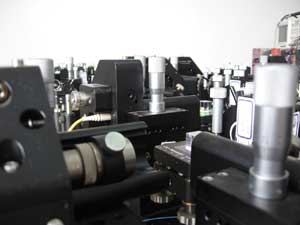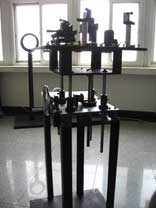
Quantum teleportation takes a giant leap
Scientists in China have successfully teleported particles farther than ever before,
achieving quantum teleportation in free space over a distance of 16 km. Previous
experiments had seen quantum teleportation via an optical fiber limited to just
600 m due to photon losses in the fiber.
Not only does free-space transmission remove the problem of photon
loss and decoherence, but it also opens the door to space-based experiments, presenting
an important step toward quantum communication applications on a global scale.
“The most interesting thing is that one can use the quantum
teleportation process to provide a quantum channel and to connect a ground station
and a satellite, or two ground stations with a satellite in between acting as a
relay,” said Cheng-Zhi Peng, one of the members of the collaborative research
team led by professor Jian-Wei Pan and comprising scientists at Tsinghua University
and the University of Science and Technology of China, Anhui.

The setup for single-photon Bell-state measurement is built on an
optical table and stabilized by active feedback control. Images courtesy of the
University of Science and Technology of China.
Although it’s called teleportation, no matter is actually
moved. Rather, the quantum state of one object is transferred to another object
thanks to a process known as quantum entanglement. This essentially allows two particles
to behave as one, regardless of how far apart they are. The particles used in this
case are photons, which can be entangled so that if one photon is vertically polarized,
then the other photon in the pair is always horizontally polarized.
In quantum teleportation, the sender, customarily called “Alice,”
transfers the quantum state of a photon (defined in terms of its polarization) to
a receiver, called “Bob.” The photon itself is not transferred: Rather
Bob’s photon acquires exactly the same polarization as Alice’s, essentially
reconstructing the original photon.
The group began by generating an entangled photon pair. They sent
one photon in the pair to “Alice,” situated at Badaling, for measurement
and sent the other photon in the pair as well as the results of Alice’s measurement
to “Bob” at Huailai in the Hebei province of northern China, 16 km away
through free space.
According to Peng, the achievement could help to construct a quantum
repeater, a quantum relay and possibly enable future distributed quantum computation.
Details of the experiments are reported in a Nature Photonics paper published online
May 16, 2010.

The split-type refracting telescope is sending light from a green laser to align both
telescopes to build a free-space channel.
Crucial to Peng’s success were two novel telescope designs
tailored for teleportation experiments. One split-type refracting telescope was
used as an optical transmitting antenna, and one off-axis parabolic reflecting telescope
was used as a receiving antenna. The combination served to optimize the transmission
efficiency and improve the stability of the free-space channel.
The team now intends to improve on its telescope design so that
the experimental results can be translated into real-life applications. “We
plan to develop large-aperture telescopes and high-accuracy acquisition, tracking
and pointing techniques,” Peng said. “We plan to measure and control
the transmission loss between low-Earth-orbit satellites and ground stations to
put satellite-ground quantum teleportation experiments into practice. Hopefully
we can achieve a teleportation-based global quantum communication network in the
future.”
Published: September 2010